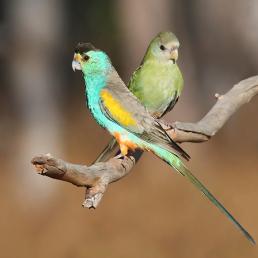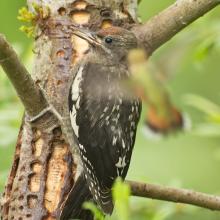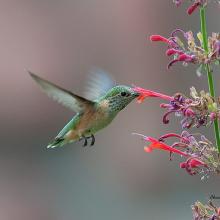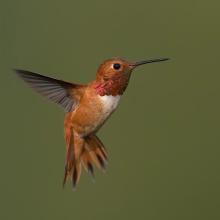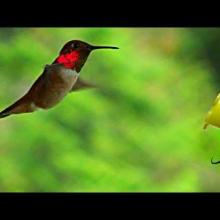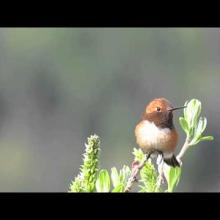

Join BirdNote tomorrow, November 30th!
Illustrator David Sibley and actor H. Jon Benjamin will face off in the bird illustration battle of the century during BirdNote's Year-end Celebration and Auction!
Does a hummingbird migrate by hitching a ride on the back of a goose? Not exactly. This Rufous Hummingbird may travel as much as 8,000 miles, as it makes its full migration loop. And a hummingbird can fly backward, forward, hover in one spot, or even flip upside-down momentarily. Learn more about hummingbird migration at JourneyNorth.
Support for BirdNote comes from the Cornell Lab of Ornithology, offering its newest online course, “The Joy of Birdwatching.” Learn more at academy.allaboutbirds.org.
BirdNote®
Hummingbird Migration Myths
Written by Frances Wood
This is BirdNote.
[Sounds of Rufous Hummingbird, both buzzing and chippity-chip sound]
Have you ever wondered how a tiny hummingbird travels thousands of miles during its migration? You’re not alone. The wonder of bird migration has puzzled and mystified people for thousands of years. Before the benefit of bird-banding research and radio transmitters to track migrating birds, folklore, myths, and legends attempted to explain this awe-inspiring phenomenon. One common myth about hummingbirds is that they hopped a ride on the backs of migrating geese.
And here’s a fascinating tale that comes from early cultures living in the dry central highlands of northern Mexico: In the fall after the hummingbirds have finished nesting, when the flowers are finished blooming and there is nothing for them to eat, hummingbirds fly to the branches of trees. They grab hold of a branch and hang down by their beaks. Dangling there, the hummingbirds dry up. They remain lifeless throughout the winter dry-season. Then in the spring, when the rains come, the hummingbirds soak up the rain and come alive again. [Thunder and rain]
Like this myth, the magical presence of hummingbirds seems to leave us all reaching to explain these avian miniatures.[Rufous Hummingbird again]
For BirdNote, I’m Mary McCann.
Support for BirdNote comes from the Cornell Lab of Ornithology, offering its newest online course, “The Joy of Birdwatching.” Learn more at academy.allaboutbirds.org.
###
Sounds of the Rufous Hummingbird (call and buzzing of wings) provided by the Macaulay Library of Natural Sounds at the Cornell Lab of Ornithology, Ithaca, New York. Recorded by G.A.Keller.
Desert ambience '2007 05 01 OSI Desert Thunder Birds', and 'Nature Sound #16 Thunderstorm' recorded by Gordon Hempton of QuietPlanet.com
Producer: John Kessler
Executive Producer: Chris Peterson / Dominic Black
© 2015 Tune In to Nature.org Revised for April 2015 / 2018 / 2020
ID#041905RUHUKPLU hummingbird-01b-2009-04-21-MM-
